Valleys and Canyons
Valleys and Canyons
Chinese Name:大理苍山桃溪谷莫催茶室
English Name: Mocui Tea House of Taoxigu Valley in Dali
Mocui Tea House and Tea Plantation is located in Taoxigu Valley of Cangshan Mountain. Tourists can pick tea in Taoxigu Valley Tea Plantation and learn how to cook tea in the workshop. Taoxigu Valley is located in the halfway of Cangshan Mountain, you can have a panoramic view of Erhai Lake from a far.
Dali Cangshan Peach Creek Valley Moxui Tea Room (大理苍山桃溪谷莫催茶室) is a charming tea house located in the scenic Peach Creek Valley at the foot of Cangshan Mountain. Known for its serene atmosphere and beautiful surroundings, it offers visitors a unique experience to enjoy traditional Chinese tea in a tranquil setting.
Visiting Dali Cangshan Peach Creek Valley Moxui Tea Room offers a serene retreat and an authentic tea experience in one of the most picturesque settings in Dali.
Chinese Name:楚雄情人谷
English Name: Valley of Love in Chuxiong
Chuxiong Valley of Love in Chuxiong City travel guide introduces the main attractions, entrance tickets booking, The best time to visit, How to Get there, the highlights, facts, history, photos, weather, accommodation, visiting routes, travel tips, tour maps of Valley of Love in Chuxiong.
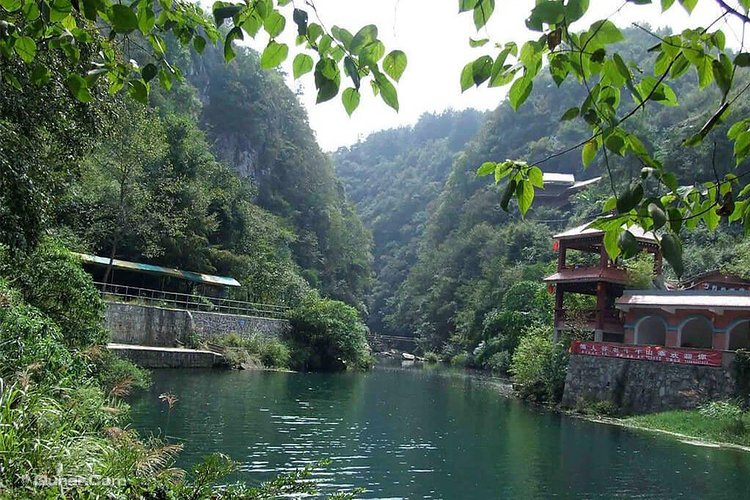
Shimen Gorge (石门峡) is located in Gasa Town (嘎洒镇), Xinping County (新平县), Yuxi City (玉溪市), Yunnan Province (云南省). Nestled in the mid-mountains on the eastern slope of the Ailao Mountains (哀牢山), this hidden gem lies at the transportation junction of three prefectures—Yuxi City (玉溪市), Chuxiong Prefecture (楚雄州), and Pu’er City (普洱市)—and five counties—Xinping (新平县), Yuanjiang (元江县), Mojiang (墨江县), Zhenyuan (镇沅县), and Shuangbai (双柏县). It is approximately 65 kilometers from Xinping County’s downtown.
Gasa Town (嘎洒镇) is known as the “Home of the Huayao Dai Ethnic Group (花腰傣族)”, with a long history and rich cultural heritage. Shimen Gorge (石门峡), celebrated for its unspoiled natural beauty and untouched landscapes, is often referred to as the “Jiuzhaigou (九寨沟) of the Ailao Mountains (哀牢山)”.
Gasa Town (嘎洒镇) is a major settlement area for the Huayao Dai people (花腰傣), where residents maintain ancient traditions and distinctive handicrafts such as weaving, embroidery, and decorative needlework. The town also hosts vibrant cultural festivals, including the famous Water Splashing Festival (泼水节).
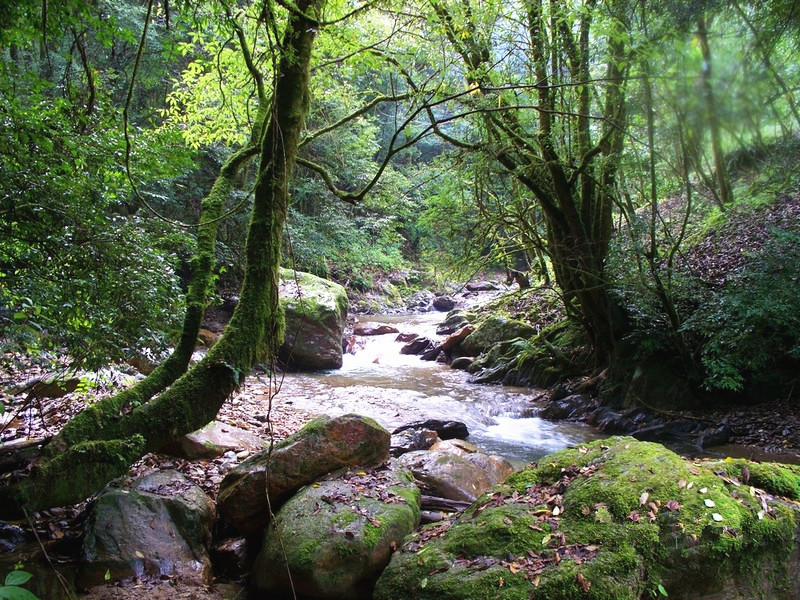
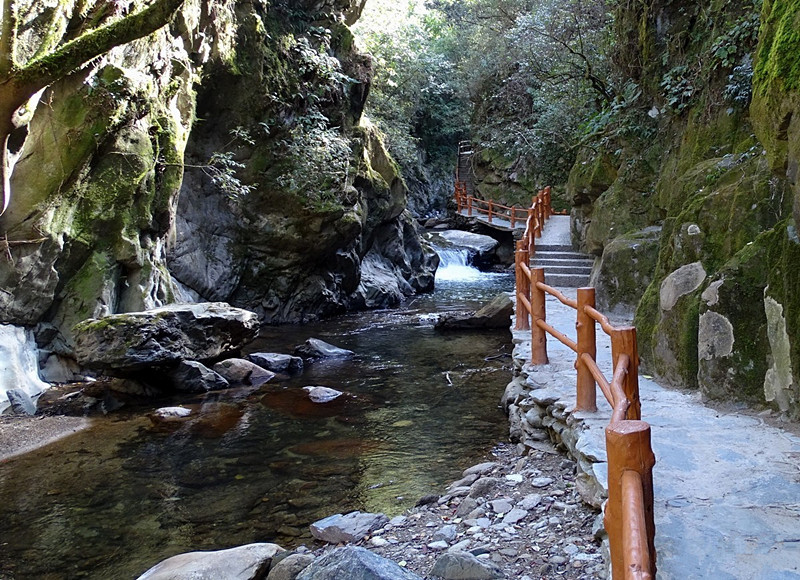
Gasa Town (嘎洒镇) experiences a subtropical monsoon climate with distinct seasons and mild temperatures. The best times to visit are in spring and autumn, when the weather is comfortable and the scenery is at its most beautiful.
Shimen Gorge (石门峡)
Named after the five naturally formed stone gates in the canyon, Shimen Gorge boasts crystal-clear streams, cascading waterfalls, and dense forests. A paradise for nature lovers.
Suggested visiting time: around 2 hours
Nanen Waterfall (南恩瀑布)
Located near Gasa Town, this powerful and majestic waterfall is one of the most famous natural sights in the Ailao Mountains.
Suggested visiting time: around 1 hour
Dabinglangyuan Village (大槟榔园村)
An ecological and cultural village where tamarind, mango, and lychee trees flourish. The villagers still preserve ancient customs and ways of life.
Suggested visiting time: around 1 hour
Entrance fee to Shimen Gorge (石门峡) is 40 RMB per person.
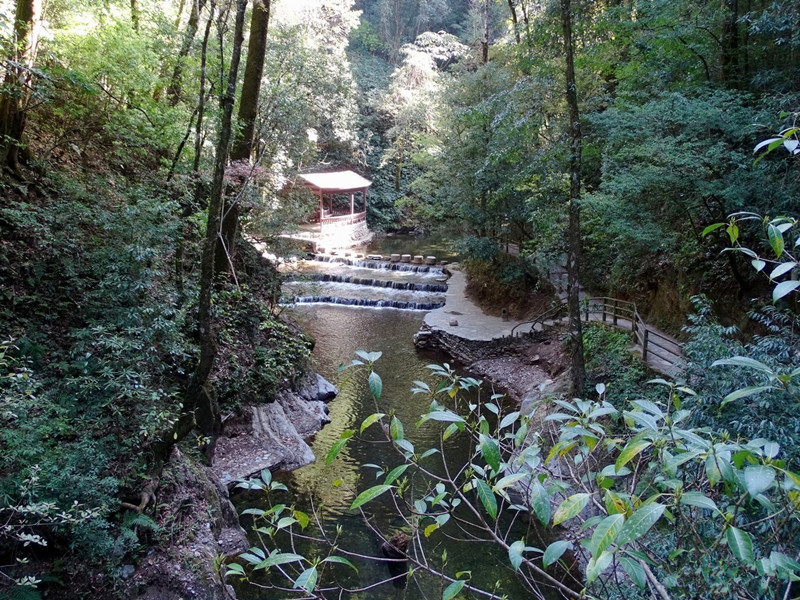
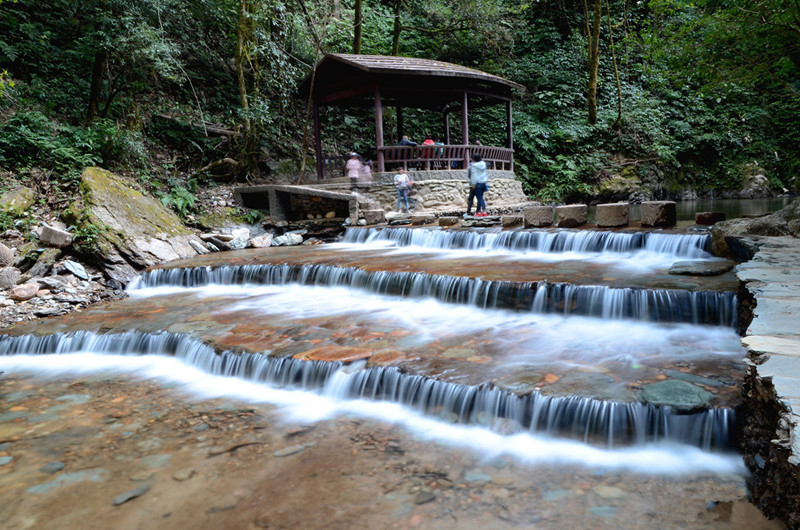
Self-Drive
From Kunming (昆明), take the Kunming–Mohan Expressway (昆磨高速) to the Xinping (新平) exit, then follow Provincial Road 307 (省道307) to Gasa Town (嘎洒镇).
Public Transport
From Kunming (昆明), take a long-distance bus to Xinping County (新平县), then transfer to a local bus or taxi to reach Gasa Town (嘎洒镇).
Specialties in Gasa Town (嘎洒镇) include bamboo tube rice (竹筒饭), grilled fish (烤鱼), and sour soup (酸汤), all reflecting the Dai ethnic flavors.
Local handicrafts such as Huayao Dai embroidery (花腰傣刺绣) and silver jewelry are popular souvenirs.
Hotels in County Center
Xinping County (新平县) has a range of hotels with moderate prices.
Homestays
Gasa Town (嘎洒镇) offers unique homestays that allow visitors to experience the local way of life.
Environmental Protection
Do not litter in the scenic area. Help protect the natural environment.
Safety Tips
Be cautious near cliffs, streams, and waterfalls. Follow all safety instructions and scenic area rules.
Day 1
Day 2
Shimen Gorge (石门峡), with its breathtaking natural scenery and deep cultural roots, draws countless visitors every year. We hope your journey through Xinping (新平) leaves you with unforgettable memories and a deep appreciation for the beauty of Shimen Gorge.
Chinese Name: 彝良县洛泽河大峡谷
English Name: Luozehe River Gorge in Yiliang County, Zhaotong
Luozehe River Gorge is located about 60 kilometers from Zhaotong City in Yiliang County, Yunnan Province. The area features a landscape with higher elevations to the south and lower elevations to the north, characterized by complex terrain with significant elevation changes, interlaced valleys, and rivers. The gorge exhibits a heavily eroded high mountain gorge terrain with karst formations. The topography includes steep mountains and sharp slopes, with a relative height difference of over 1,500 meters. Cross-sections of the gorge often present “V” or “U” shapes, with slopes typically ranging from 35 to over 45 degrees. The slopes also contain varying sizes of gentle terraces.
Luozehe River Gorge falls within a warm and humid river valley climate zone. Winters and springs are mild, while summers and autumns are hot. The area does not experience frost or permafrost. The annual average temperature is around 16°C, with the highest temperatures reaching up to 40°C and the lowest around -4°C. The annual rainfall is approximately 800 millimeters.
The Luozehe River flows through several towns, including Luozehe Town, Jiaokui Town, Long’an Township, and Zhongming Township, before joining the Guan River. The section known as “Luozehe River” extends over 140 kilometers, offering a rich aquatic ecosystem with a variety of fish species. The steep cliffs along the gorge give it a dramatic landscape comparable to the grandeur of the Three Gorges. A notable feature is the Luozehe Waterfall (also known as Biaoshuiyan), which is the second-highest waterfall in Yunnan, with a drop of approximately 300 meters.
Perched atop the Guoquanyan cliffs along the river is the Longshi Manor, resembling an ancient fortress. The historical castle known locally as “Luosan Laoye’s House” is situated on Maomao Mountain, which dominates the river’s edge, controlling the strategic passage into Zhaotong. The cliffs rise precipitously, forming natural defensive walls that were once considered impenetrable. The gorge is home to ethnic minorities, including the Miao and Yi peoples, who maintain their traditional customs and cultural practices.
The Luozehe River Gorge also contains relics of hanging coffins on the Guoquanyan cliffs, and the cliffs and mountainsides provide habitat for various wildlife species, such as monkeys and rock sheep. The gorge is steeped in local legends and myths that have been passed down through generations, enriching its cultural landscape.
The upper reaches of the river are flanked by the Luozehe Industrial Zone, rich in coal and lead-zinc resources. The area boasts substantial reserves and high-quality minerals, making it a major industrial base for coal and lead-zinc in Zhaotong City. It also serves as an industrial tourism area for Yiliang County.
Luozehe River Gorge is a masterpiece of natural beauty and geological wonder, combining scenic landscapes, historical and cultural significance, and abundant natural resources. Its unique environment makes it a popular spot for rafting and other outdoor recreational activities, offering visitors a blend of natural splendor and cultural richness.
Location: Yiliang County, Zhaotong City, Yunnan Province, China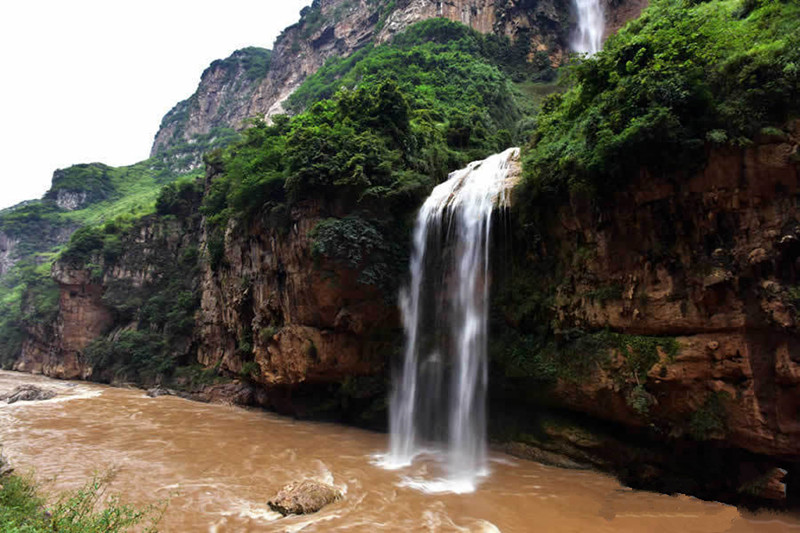
Location: Yiliang County, Zhaotong City, Yunnan Province, China
To visit the Luozehe River Gorge, you’ll need to travel to Yiliang County, located approximately 60 kilometers from Zhaotong City. Here are the transportation details to help you reach the gorge:
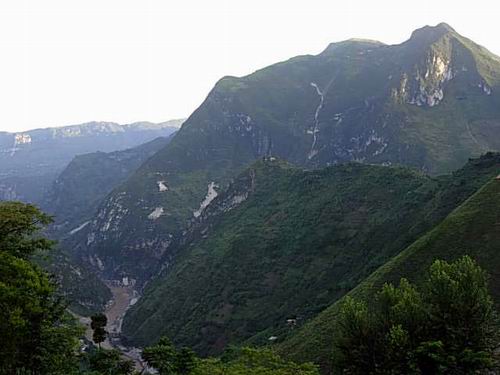
Whether you choose to drive or use public transportation, visiting Luozehe River Gorge offers a unique experience combining natural beauty, cultural heritage, and outdoor adventure in Yunnan Province.
Chinese Name: 丘北县猴爬岩大峡谷
English Name: Houpayan Grand Canyon in Qiubei County, Wenshan
Location:
Houpayan Grand Canyon is located in the northeast of Qiubei County, about 56 kilometers from the county seat. The canyon is a natural wonder, formed by the combination of steep gorges, diverse flora and fauna, waterfalls, underground rivers, and caves. The area is named “Houpayan” (literally “Monkey Climb Rock”) because monkeys are often seen playing on the sheer cliffs. The number of monkeys ranges from dozens to over a hundred at any given time.
Geographical Features:
The canyon is situated in the upper reaches of the Qingshui River, between Yudong and Gedor in Wenliu Township, Qiubei County. The canyon spans a length of 9 kilometers, featuring cliff formations, waterfalls, underground rivers, and caves. The width at the top ranges between 500-800 meters, while at the bottom, it varies from 30-100 meters. The vertical drop from the cliff tops to the riverbed is typically 400-500 meters, with the highest point reaching 560 meters. The canyon was formed through prolonged erosion and karst dissolution, creating a landscape of towering cliffs, narrow river passages, and dramatic natural scenery.
Natural Environment:
Both sides of the canyon are lined with rare subtropical virgin forests, offering dense shade from various species of trees such as banyan, Cedrela sinensis, and Broussonetia. The area is a haven for wildlife, including groups of monkeys, wild boars, mountain goats, flying foxes, pythons, eagles, foxes, and pangolins. Due to its remote location and challenging access, Houpayan Grand Canyon has remained relatively unknown, even to many locals.
Tourism and Attractions:
The Houpayan Grand Canyon is renowned for its characteristics described as “danger in the gorge, fun with the monkeys, soul in the greenery, and tranquility in the secluded environment.” It is an ideal destination for sightseeing, rafting, and adventure. In winter, visitors can enjoy the breathtaking views of cloud seas and mountain landscapes, and embark on an adventurous journey.
The entire canyon is considered a “natural zoo and botanical garden,” with lush tropical and subtropical vegetation, diverse animal life, and well-preserved ancient plant communities. Groups of monkeys are a common sight on the cliffs, adding to the canyon’s charm.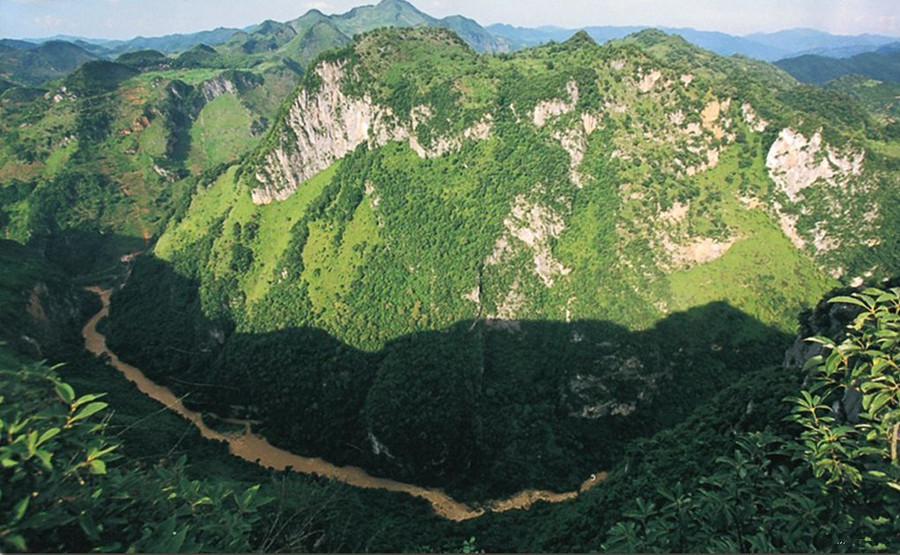
Development Plans:
Qiubei County plans to capitalize on the steep cliffs of Houpayan by constructing a personalized viewing platform extending partially over the edge, providing visitors with both thrilling and scenic experiences. Along both sides of the Qingshui River, a scenic walkway with protective railings is planned to create a primary tourist route. A viewing pavilion made of wood and bamboo will be built as a resting area, offering panoramic views of the canyon.
Visitors can look back at the peak of “Houpayan” from the banks of the Qingshui River, taking in the majestic views of this natural wonder.
Mocui Tea House and Tea Plantation is located in Taoxigu Valley of Cangshan Mountain. Tourists can pick tea in Taoxigu Valley Tea Plantation and learn how to cook tea in the workshop. Taoxigu Valley is located in the halfway of Cangshan Mountain, you can have a panoramic view of Erhai Lake from a far.
Chinese Name: 大理苍山桃溪谷
English Name: Taoxigu Valley in Cangshan, Dali
Taoxigu Valley is a scenic area located within Cangshan Mountain, Dali, Yunnan. It is renowned for its pristine natural beauty and rich ecological resources. The valley is nestled at an altitude of around 2,200 meters and is adjacent to the famous Chongsheng Temple.
Taoxigu Valley is a destination that combines natural beauty with cultural and ecological experiences, making it an ideal spot for relaxation and exploration in Dali.
For a deep connection with nature, visit the Mo Cui Tea House at Taoxigu Eco-Tourism Resort. Located in the scenic area of Cangshan Taoxigu Valley, the tea garden offers a unique experience. With tea trees about 70 years old, the environment is perfect for producing high-quality, organic tea. The area provides stunning views of Dali ancient city and Erhai Lake. Enjoy the beauty of blooming flowers in spring and the soothing sounds of streams in summer. Engage in tea picking, enjoy the mountain breeze, and savor tea made with your own hands. The experience is both relaxing and rewarding, allowing you to create a personal tea blend infused with the essence of the mountains.
Chinese Name: 景谷县芒玉大峡谷
English Name: Mangyu Grand Canyon in Jinggu County, Puer
ADD:普洱市景谷县威远镇联合村
Overview:
Mangyu Grand Canyon, located in the unified village of Weiyuan Town, Jinggu County, Puer City, is a stunning natural wonder known for its deep gorges, steep mountain peaks, and diverse landscapes. Approximately 18 kilometers from the county seat, it can be reached within a 30-minute drive, making it an ideal spot for sightseeing, outdoor activities, and photography. The canyon is part of the Wuliang Mountain range, covering an area of 1,225 hectares, and stretches 7 kilometers in length. It showcases a classic Danxia landform, characterized by striking red sandstone formations.
Features:
Travel Tips:
Mangyu Grand Canyon offers an unparalleled opportunity to escape urban life, immerse yourself in nature, and explore both its scenic beauty and cultural depth.
Chinese Name:西盟县木依吉神谷
English Name: Muyiji Holy Valley and Cliff Painting in Ximeng County, Puer
The Muyiji Holy Valley is situated on the back mountains of Mengsuo Longtan in Ximeng County, Puer City, Yunnan Province. It is located 4.8 kilometers south of Ximeng County.
The Muyiji Holy Valley is a sacred site for the Wa people, embodying their beliefs in natural worship, deity worship, and ancestor worship. The Wa people believe that the world of spirits is as complex as the human world, with desires and needs for food, water, clothing, housing, and labor. They hold that all things were created by the deity Muyiji, who governs life and death and assigns different roles to various plants and animals. Rituals such as drum performances, ox sacrifices, and offerings of human heads are conducted to honor Muyiji. Displeasing this deity could result in poor harvests or natural disasters. Consequently, the Wa people annually perform rituals to seek blessings and protection from Muyiji.
Notable features of the Muyiji Holy Valley include ancient banyan trees, the Muyiji statue, head posts, and sacred ponds. The valley, along with Mengsuo Longtan, Longmo Temple, Sigangli, and Likang Waterfall, forms a scenic area that integrates nature worship, deity worship, ancestor worship, and natural beauty in Ximeng Wa Mountain.
The valley is nestled among mountains and near water, with a serene environment. Clear spring water flows from ancient forests, and various unique banyan trees can be seen throughout the area.
In February 2020, to honor medical staff for their dedication during the pandemic, the site offered free admission to medical workers and two companions from the restoration of the scenic area until December 31, 2020. Visitors with valid medical credentials (physician or nurse certificates) could access the site by inquiring at the tourist center.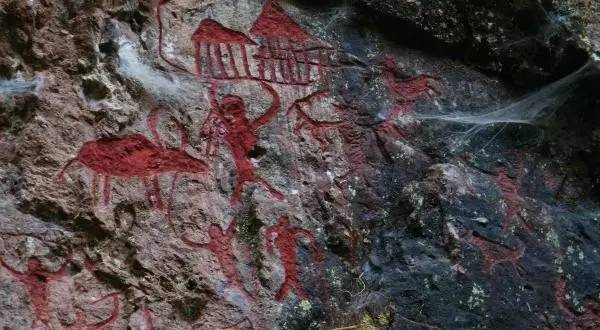
The cliff walls of Muyiji Holy Valley feature red ochre rock paintings that narrate ancient Wa legends. The valley also served as a filming location for the movie Ghost Blows Out the Light: The Bug Valley of Yunnan, adding to its mysterious and fantastical allure.








Valleys and Canyons
Chinese Name:大理苍山桃溪谷莫催茶室 English Name: Mocui Tea House of Taoxigu Valley in Dali Mocui Tea House and Tea Plantation is located in Taoxigu Valley of Cangshan Mountain. Tourists can pick tea in Taoxigu Valley Tea...
Chinese Name:楚雄情人谷 English Name: Valley of Love in Chuxiong Chuxiong Valley of Love in Chuxiong City travel guide introduces the main attractions, entrance tickets booking, The best time to visit,...
Shimen Gorge (石门峡) is located in Gasa Town (嘎洒镇), Xinping County (新平县), Yuxi City (玉溪市), Yunnan Province (云南省). Nestled in the mid-mountains on the eastern slope of the Ailao...
Chinese Name: 彝良县洛泽河大峡谷 English Name: Luozehe River Gorge in Yiliang County, Zhaotong Location and Geographical Features Luozehe River Gorge is located about 60 kilometers from Zhaotong City in Yiliang...
Chinese Name: 丘北县猴爬岩大峡谷 English Name: Houpayan Grand Canyon in Qiubei County, Wenshan Location: Houpayan Grand Canyon is located in the northeast of Qiubei County, about 56 kilometers from the...
Mocui Tea House and Tea Plantation is located in Taoxigu Valley of Cangshan Mountain. Tourists can pick tea in Taoxigu Valley Tea Plantation and learn how to cook tea in the workshop. Taoxigu Valley...
Chinese Name: 景谷县芒玉大峡谷 English Name: Mangyu Grand Canyon in Jinggu County, Puer ADD:普洱市景谷县威远镇联合村 Overview: Mangyu Grand Canyon, located in the unified village of Weiyuan Town, Jinggu County, Puer City,...
Chinese Name:西盟县木依吉神谷 English Name: Muyiji Holy Valley and Cliff Painting in Ximeng County, Puer Location The Muyiji Holy Valley is situated on the back mountains of Mengsuo Longtan in...
Don't assume you're restricted to the main hubs of Beijing and Shanghai, our tours can start from any city.
For your safety, please register with the Embassy.
Exchange some local currency for your trip
Start planning your tailor-made holiday to China by contacting one of our specialists. Once enquired, you’ll get a response within 0.5~23.5 hours.

Address: Building 4, Yifuyuan, Hehong Road, Xishan District, Kunming, Yunnan, China
Wechat/QQ: 270384698
Office Call: 86-18812220370
Email: Trip@YasoTrip.com
Facebook Page:
https://www.facebook.com/YasoTrip
Tel/WhatsApp: +8618088243690
Trip@YasoTrip.com
Daily: 9:00 am - 6:00 pm
Copyright © 2008 Yaso Trip. All rights reserved
Address: Building 4, Yifuyuan, Hehong Road, Xishan District, Kunming, Yunnan, China
Wechat/QQ: 270384698
Office Call: 86-18812220370
Email: Trip@YasoTrip.com
Facebook Page:
https://www.facebook.com/YasoTrip
Tel/WhatsApp: +8618088243690
Trip@YasoTrip.com
